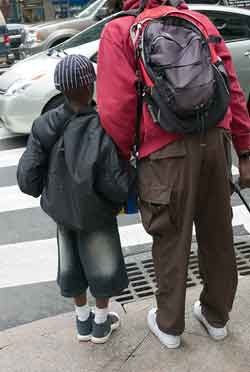
Source: L1069729, Susan Sermoneta, Flickr
“When I was your age, we didn’t have buses that took us to school; we had to walk, and it was uphill both ways!” Have you ever heard an adult say this? It’s a little exaggerated because one place cannot be uphill from another both coming and going, but the point may be something like this: Things were different in my day. Historical, cultural, and physical setting plays a part in our lives. How could it not?
In real life, things are different owing to the technology and culture of the times. In literature, characters act and react to the historical and cultural settings in which they live.
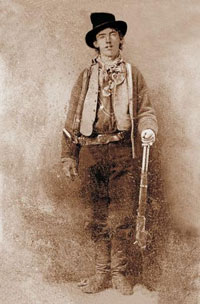
Source: Billy the Kid corrected, Ben Wittick, Wikimedia
Historical settings and character development
Billy the Kid, the main character in the novel by Larry McMurtry titled Anything for Billy, lived in the western United States in the nineteenth century, a time when communication wasn’t as easy as it is today. He couldn’t learn that he was about to walk into an ambush by picking up a cell phone. The slowness of communication becomes part of the plot and affects his interactions with his community and other characters. Those interactions, in turn, bear on his thoughts, feelings, and actions, which help drive the plot and theme of the story.
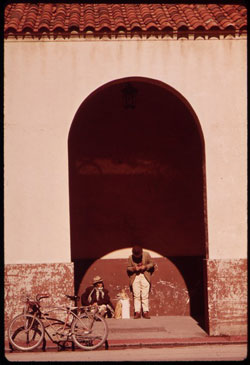
Source: PASSAGEWAY IN THE OLD MEXICAN MARKET AREA JUST WEST OF DOWNTOWN SAN ANTONIO. PRESENT PLANS CALL FOR REVITALIZATION OF... - NARA – 547748, national Archives and Record Administration, Wikimedia
Cultural settings and character development
The cultural setting of a piece of literature includes patterns of behavior and beliefs that dominate the society in which the characters live. Family relationships; shared ancestry, history, homeland, and language; moral values; class structures; gender roles; and dialect are all part of the cultural environment. All these elements play important roles in a story’s plot, character development, and theme.
Because the historical setting and cultural setting of a story often go hand-in-hand, we will analyze all their effects in one story. Read the following set of guiding questions, and then read the excerpt. (Please note that these questions are designed to help you analyze, infer, and draw conclusions in complete texts and may or may not apply to any one excerpt of a story.)
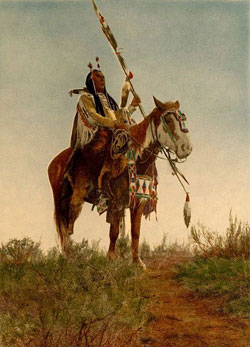
Source: ApsarokaHorse, Edward S. Curtis, Wikimedia
Guiding questions for historical settings
- When does the story take place, and how does the author communicate this to the reader?
- What elements of this time period stand out that might affect the characters’ beliefs or values?
- How do characters react, interact, or change relative to the historical setting? How can you infer what life was like during that period; for example, what do characters say, think, or do that they might not do in another place or time?
Guiding questions for cultural settings
- What details of the setting (moral, religious, ethnic, etc.) reflect the culture of the society in which the characters live?
- How do the characters’ thoughts, actions, and speech reflect the cultural setting?
- What conflicts does the cultural setting present for the characters, and how are these conflicts resolved?
“A Man to Send Rain Clouds” is a short story written by Leslie Marmon Silko, a member of the Laguna Pueblo tribe. The story takes place on a pueblo in the southwestern part of the United States in the middle to late twentieth century. In the story, the old Native American sheepherder Teofilo has died and been found by younger family members. What takes place in the excerpt below is a description of how they take care of the old man’s body in preparation for burial.
Before they wrapped the old man, Leon took a piece of string out of his pocket and tied a small gray feather in the old man’s long white hair. Ken gave him the paint. Across the brown wrinkled forehead he drew a streak of white, and along the high cheekbones, he drew a strip of blue paint. He paused and watched Ken throw pinches of corn meal and pollen into the wind that fluttered the small gray feather. Then Leon painted with yellow under the old man’s broad nose; and finally, when he had painted green across the chin, he smiled.
“Send us rain clouds, Grandfather.” They laid the bundle in the back of the pickup and covered it with a heavy tarp before they started back to the pueblo.
As the story continues, we read that the relatives don’t tell the Catholic priest about Teofilo’s death until they ask him to come to the cemetery with holy water. The priest is reluctant because he wasn’t given the opportunity to give a funeral mass or Last Rites to the old man. In the end, he agrees, and Silko describes the mistrust the priest has for the Indians as he approaches the grave site and sees the bundle in a red blanket. Silko describes him “wondering if it wasn’t some perverse Indian trick—something they did in March to ensure a good harvest—wondering if old Teofilo was actually at sheep camp.” Leon, Teofilo’s grandson, watches as the priest sprinkles the holy water and then walks away.
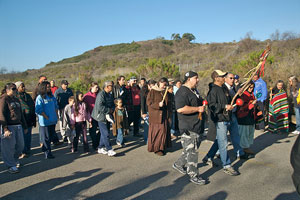
Source: Save Panhe and San Onofre!, The City Project, Flickr
Leon turned to look up at the high blue mountains in the deep snow that reflected a faint red light from the west. He felt good because it was finished, and he was happy about the sprinkling of the holy water; now the old man could send them big thunderclouds for sure.